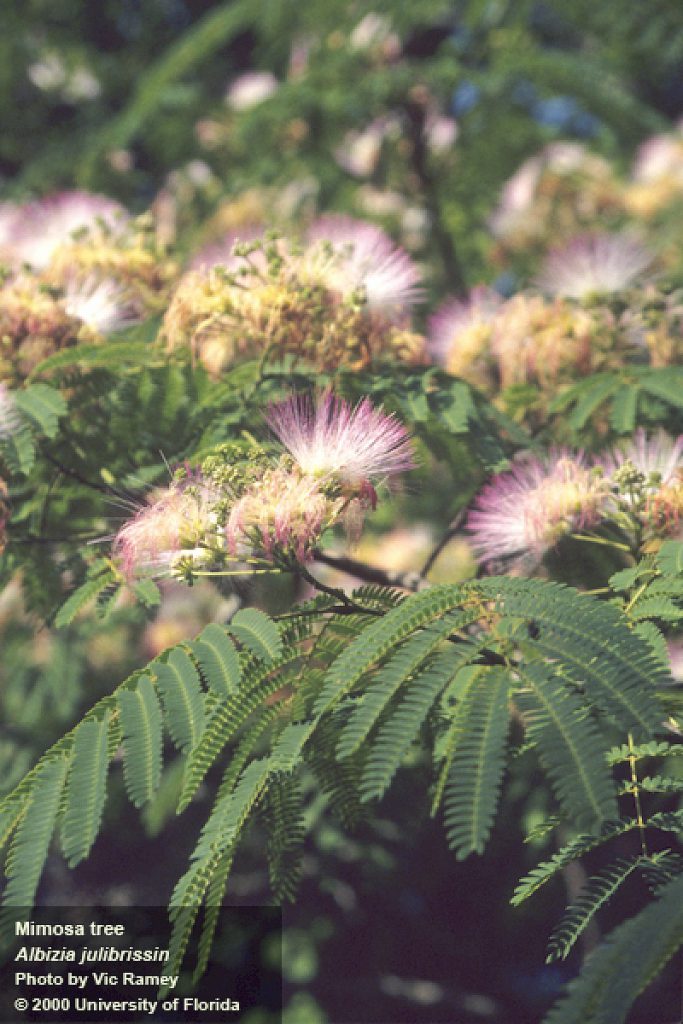Mimosa Silk Tree (Albizia julibrissin)
I’ll be the first to admit – this is a beautiful tree. Unfortunately, it is highly invasive. You can easily see this tree sprinkled throughout the landscape because of its beautiful flowers and unique leaves. Originally introduces in the US in the 16th Century, Mimosa Silk Tree now spreads easily along forest edges and pops up in our landscapes. It produces very attractive flowers and long straw-colored bean pods about 6″ long. Although it is not documented in Nassau County, it is located in North Florida. Keep an eye out for this invasive tree and report it if you discover it in your landscape or natural area.

Control
Preventative
I admit it – this is a beautiful tree. Don’t let its beauty tempt you – it is highly invasive. To prevent the spread of Mimosa Silk Tree, do not purchase, transport, buy, sell, or trade this plant, no matter how tempting this landscaping siren may be. Additionally, if this tree pops up in your landscape, the removal of seed pods will help reduce its spread.
Cultural/Physical
Hand-pulling seedlings and saplings control its spread. Although, homeowners will find the removal of larger trees more difficult. If you find yourself tempted, think of the beautiful landscape alternatives, which include Bottlebrush (Callistemon citrinus or C. linearis), Fringe Tree (Chionanthus virginicus), Cassia (Senna ligustrina), or Acacia (Acacia farnesiana).
Mechanical
Controlling Mimosa Silk tree is most effective prior to flowering and seed production. For small saplings and seed pods, it is easy for homeowners to easily remove and dispose of plants. For larger trees, felling trees closely to ground level improves control. Although, due to their resilience, continually cutting sprouts is required and trying to remove as many of the roots as possible because the Mimosa will sprout from the remaining fragments.
Biological
There are no known biological controls.
Chemical
After cutting the Mimosa Silk Trees, a 50% Garlon 3A or 10% Milestone herbicide mixture may be applied to the stump. This cut-stump method helps control future growth from the roots and the remaining stump. Additionally, seedlings and small trees may be sprayed with 2% glyphosate.
Conclusions
The showy, yet highly invasive plant spreads aggressively across the landscape. Therefore, if you or someone you know is having issues managing this invasive or any other invasive plants within your landscapes, reach out to your county extension office for more information. The invasion of the landscape snatchers has begun, but we can stop it!
More Information:
Blog Series
Like what you are reading? Therefore, check out all the published blogs in this series. https://blogs.ifas.ufl.edu/nassauco/tag/invasion-of-the-landscape-snatcherss/
Or quickly jump to the individual blogs in the series:
Invasion of the Landscape Snatchers
Tuberous Sword Fern (Nephrolepis cordifolia)
Coral Ardisia (Ardisia crenata)
Wild Taro (Colocasia esculenta)
Mexican Petunia (Ruellia simplex)
Mother of Millions (Kalanchoe x houghtonii)
Mimosa Silk Tree (Albizia julibrissin)
Social Media Pages:
Other Media Pages
- Blog Page
- Nassau County Extension Page
- IFAS Assessment
- Center for Aquatic and Invasive Plants
- Contact Information
 0
0
